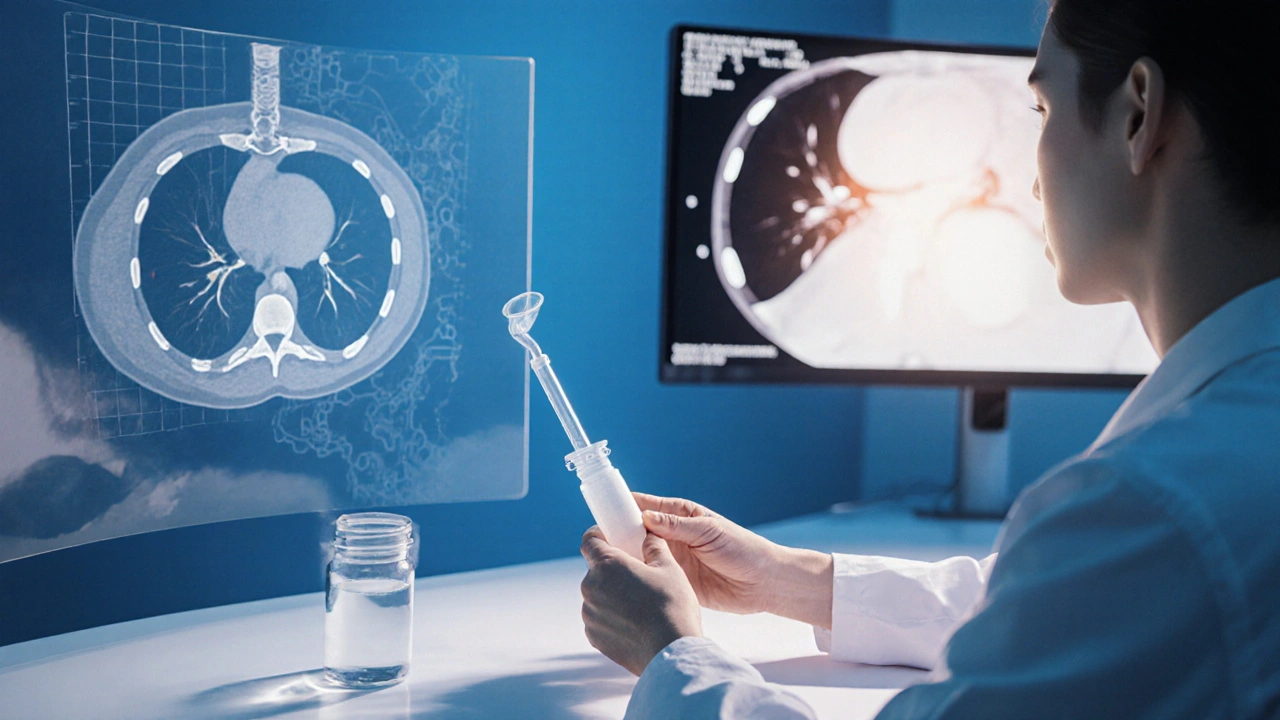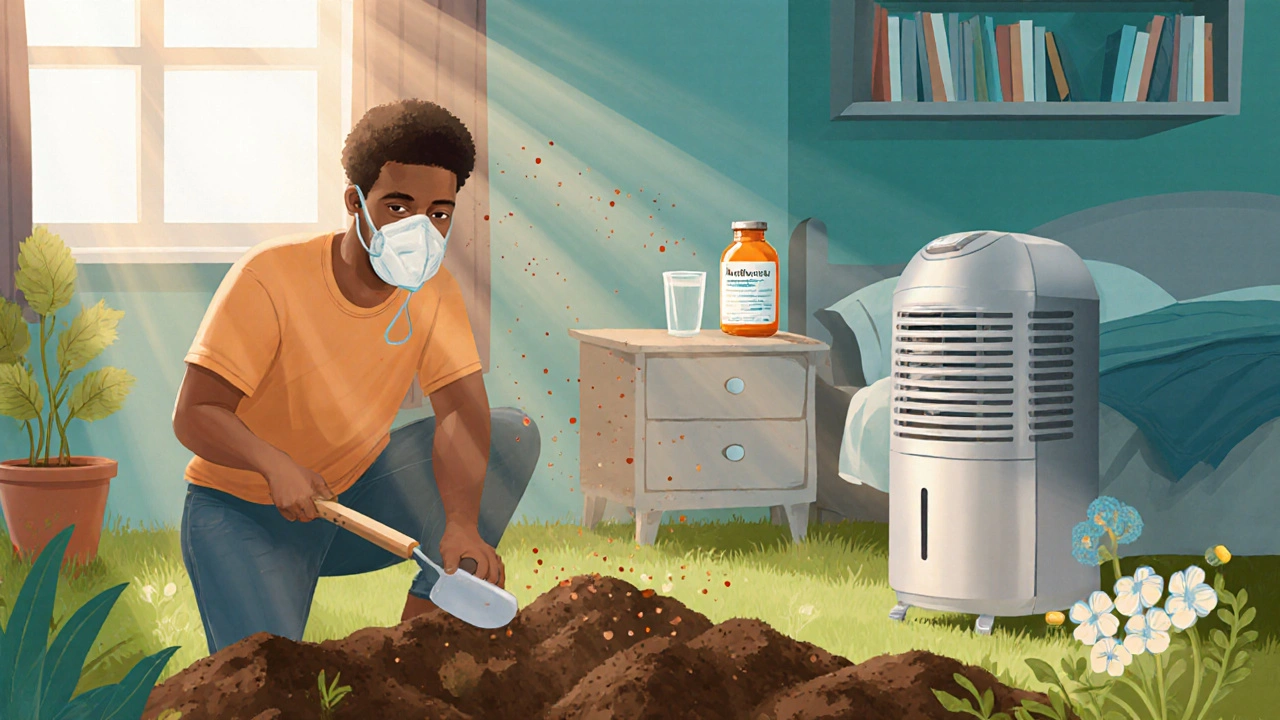Fungal Lung Infection Symptom Checker
Select your symptoms (you can choose multiple):
Select your risk factors:
Click "Check Risk" to analyze your symptoms and risk factors:
Potential Infection Match
Below are key fungal lung infections and their typical characteristics:
- Aspergillosis: Often affects those with asthma or immunosuppression; symptoms include cough, hemoptysis, wheeze
- Histoplasmosis: Common in Ohio River Valley; symptoms include fever, night sweats, chest pain
- Coccidioidomycosis: Found in Southwest US; symptoms include fever, cough, pleuritic pain
- Pneumocystis pneumonia: Primarily affects immunocompromised individuals; symptoms include progressive dyspnea, non-productive cough
- Cryptococcosis: Worldwide; symptoms include headache, fever, lung nodules
When a fungus slips into the airways, it can turn a simple cough into a serious health scare. Fungal respiratory infections are a group of illnesses caused by fungi that invade the lungs and air passages. They range from mild irritation to life‑threatening pneumonia, especially for people with weakened immune systems.
Why the Lungs Are a Target for Fungi
The lungs constantly filter the air we breathe, making them a natural entry point for airborne spores. Once inhaled, spores can settle in the bronchi or alveoli. If the immune system is compromised-or if the fungal load is high-the spores germinate, forming hyphae that damage tissue and trigger inflammation.
Common Fungal Culprits
Not all fungi behave the same way. Below are the six fungi most often linked to respiratory problems.
- Aspergillosis is caused by Aspergillus species, especially A. fumigatus. It thrives in decaying organic matter and can affect anyone, but allergic reactions are common in otherwise healthy people.
- Histoplasmosis stems from Histoplasma capsulatum, a fungus that lives in bird and bat droppings, often in caves or old buildings.
- Coccidioidomycosis (Valley fever) originates from Coccidioides immitis and C. posadasii found in arid soil of the southwestern United States and parts of Central America.
- Pneumocystis pneumonia (PCP) is caused by Pneumocystis jirovecii, a yeast‑like organism that lung‑infects people with severe immune suppression.
- Cryptococcosis results from Cryptococcus neoformans, a yeast found in pigeon droppings and soil.
- Antifungal therapy includes drugs like voriconazole, itraconazole, amphotericin B, and newer agents such as isavuconazole, each chosen based on the specific fungus and patient factors.
How These Infections Show Up
Symptoms often overlap with bacterial pneumonia, making diagnosis tricky. Typical signs include:
- Persistent cough (sometimes producing sputum with a “fungal” odor)
- Shortness of breath, especially during exertion
- Fever and chills that linger despite antibiotics
- Chest pain that worsens with deep breaths
- Weight loss or night sweats in chronic cases
Because the presentation is nonspecific, clinicians rely heavily on diagnostic testing to pinpoint the cause.

Diagnostic Toolbox
Accurate identification hinges on a mix of imaging, lab work, and sometimes invasive procedures.
- Imaging: Chest X‑rays may reveal nodules or infiltrates, while high‑resolution CT scans can show characteristic patterns-halo signs for invasive aspergillosis or cavitary lesions for histoplasmosis.
- Serology: Antibody or antigen tests (e.g., Histoplasma antigen in urine) help detect active infection, especially in immunocompromised patients.
- Culture and PCR: Sputum, bronchoalveolar lavage (BAL), or tissue samples are cultured on special media; PCR can rapidly detect fungal DNA.
- Biopsy: In stubborn cases, a lung biopsy confirms fungal invasion under the microscope.
Combining these methods boosts diagnostic confidence and guides therapy.
Who’s at Risk?
While anyone can inhale spores, certain groups face higher odds of severe disease.
- People with HIV/AIDS or low CD4 counts (especially for PCP)
- Organ transplant recipients on immunosuppressants
- Cancer patients undergoing chemotherapy
- Individuals on chronic corticosteroid therapy
- Those with underlying lung conditions like COPD or asthma
- People living or working in endemic areas (e.g., the Ohio River Valley for histoplasmosis, the Southwest desert for coccidioidomycosis)
Treatment Strategies
Prompt antifungal therapy can mean the difference between recovery and chronic lung damage. Treatment choices depend on the organism, severity, and patient health.
- Aspergillosis: First‑line is voriconazole; for allergic bronchopulmonary aspergillosis, steroids plus antifungals are common.
- Histoplasmosis: Mild cases may resolve without medication, but moderate-severe disease calls for itraconazole for 12 weeks or longer.
- Coccidioidomycosis: Fluconazole or itraconazole for several months; disseminated disease often needs amphotericin B initially.
- Pneumocystis pneumonia: High‑dose trimethoprim‑sulfamethoxazole (TMP‑SMX) for 21 days, with adjunctive steroids for severe hypoxia.
- Cryptococcosis: Induction with amphotericin B plus flucytosine, followed by fluconazole maintenance.
Therapeutic monitoring is crucial-some drugs interact with common medications, and levels may need adjustment in liver or kidney disease.

Prevention and Lifestyle Tips
Reducing exposure and bolstering immunity cut the odds of infection.
- Avoid disturbed soil or dust in endemic regions; wear respirators when gardening or doing demolition work.
- Keep indoor humidity low to discourage mold growth; use dehumidifiers in basements.
- Individuals on immunosuppressive therapy should discuss prophylactic antifungals with their doctors.
- Maintain a balanced diet, regular exercise, and up‑to‑date vaccinations to support overall immune health.
- For HIV patients, adherence to antiretroviral therapy dramatically lowers PCP risk.
Key Takeaways
Fungal respiratory infections are often overlooked, yet they can cause prolonged cough, breathing trouble, and serious lung damage. Knowing the common culprits-Aspergillus, Histoplasma, Coccidioides, Pneumocystis, and Cryptococcus-helps you spot red flags early. Prompt diagnosis through imaging, serology, and cultures followed by targeted antifungal therapy improves outcomes. If you’re immunocompromised or live in an endemic zone, take extra precautions to limit spore inhalation.
| Infection | Causative Fungus | Typical Region | Common Symptoms | High‑Risk Groups | First‑Line Treatment |
|---|---|---|---|---|---|
| Aspergillosis | Aspergillus spp. | Worldwide (soil, compost) | Cough, hemoptysis, wheeze | Asthma, COPD, immunosuppressed | Voriconazole |
| Histoplasmosis | Histoplasma capsulatum | Ohio River Valley, Central US | Fever, night sweats, chest pain | Immune‑deficient, heavy exposure | Itraconazole (12weeks) |
| Coccidioidomycosis | Coccidioides immitis/posadasii | Southwest US, Mexico | Fever, cough, pleuritic pain | Immunocompromised, pregnant | Fluconazole or itraconazole |
| Pneumocystis pneumonia | Pneumocystis jirovecii | Worldwide (airborne) | Progressive dyspnea, non‑productive cough | HIV/AIDS, transplant recipients | TMP‑SMX + steroids (severe) |
| Cryptococcosis | Cryptococcus neoformans | Global (pigeon droppings) | Headache, fever, lung nodules | HIV, organ transplant | Amphotericin B + flucytosine, then fluconazole |
Frequently Asked Questions
What are the most common fungal infections that affect the lungs?
The most frequently encountered ones are aspergillosis, histoplasmosis, coccidioidomycosis (Valley fever), Pneumocystis pneumonia, and cryptococcosis. Each has a distinct geographic footprint and set of risk factors.
How do doctors differentiate a fungal pneumonia from a bacterial one?
Because symptoms overlap, doctors rely on imaging patterns, specific lab tests (like fungal antigens or PCR), and sometimes invasive sampling (BAL or biopsy). A lack of response to antibiotics also raises suspicion.
Can healthy people develop serious fungal lung disease?
Yes, though severe disease is rarer. For example, allergic bronchopulmonary aspergillosis can affect otherwise healthy asthmatics, and massive spore exposure (e.g., during demolition) can cause acute lung injury in any adult.
What are the main treatment options for these infections?
Treatment usually involves oral or intravenous antifungal drugs tailored to the pathogen. Voriconazole works well for aspergillosis; itraconazole is often chosen for histoplasmosis; fluconazole or itraconazole for coccidioidomycosis; TMP‑SMX for PCP; and amphotericinB based regimens for cryptococcosis.
How can I lower my risk of inhaling harmful fungal spores?
Stay away from dusty construction sites, wear a N95 mask when gardening in endemic areas, keep indoor humidity below 60%, and for immunocompromised patients, discuss prophylactic antifungals with a physician.

Ever wonder why the air we breathe can turn hostile overnight? It feels like the government’s secret labs are spraying spores to keep us on edge, and every cough could be a warning sign. I’ve read enough about Aspergillus and Histoplasma to know they’re not just science‑fiction monsters. Stay vigilant, keep your windows closed when dust kicks up, and trust no one who says it’s "just a cold."
One must, undeniably, recognize the nuance in fungal pathogenesis,; the literature, however, often glosses over critical epidemiological data,; consequently, clinicians risk misdiagnosing patients, especially in endemic regions.
While you all sound convinced that spores are a grand conspiracy, the reality is that most healthy adults clear them without a second thought. The data simply shows low incidence in immunocompetent people. So, let’s not dramatize every sneeze.
i dont think anyone needs a fancy tool for this.
It is incumbent upon us to scrutinize the presented data with a skeptical eye, particularly when the authors claim a universal applicability of their diagnostic algorithm. The omission of regional variance in spore concentration renders the conclusions somewhat presumptuous. Moreover, the reliance on self‑reported symptoms without corroborating laboratory values weakens the overall argument.
When we dissect the lexicon of fungal nomenclature, we encounter a tapestry of etymological roots that mirror the organisms’ ecological niches. Aspergillus, for instance, derives from the Latin *asper* meaning "rough," a nod to the spore‑bearing structures that resemble tiny brushes. Histoplasma, on the other hand, couples *histo* (tissue) with *plasma* (form), aptly describing its proclivity for infiltrating host tissue. Coccidioides, translating to "berry‑like" in Greek, references the characteristic spherules that erupt like grapes within the lung parenchyma. One must appreciate that these linguistic choices are not merely academic; they often hint at pathogenic mechanisms. The "halo sign" observed in CT imaging of invasive aspergillosis, for example, correlates with hemorrhagic infarction surrounding a fungal lesion, a visual echo of the organism’s invasive strategy. Meanwhile, the antigen detection assays for Histoplasma leverage cell wall glucans that are uniquely abundant in this fungus, allowing for rapid non‑invasive diagnosis. It is also noteworthy that the therapeutic landscape is governed by pharmacokinetic nuances; voriconazole’s CYP450 metabolism demands therapeutic drug monitoring to avoid neurotoxicity, whereas itraconazole’s lipophilicity ensures accumulation in pulmonary tissue, enhancing efficacy against Histoplasma. In immunocompromised hosts, the balance between host defense and fungal virulence tips dramatically, rendering even low‑grade exposures lethal. Therefore, clinicians must integrate epidemiological data, imaging patterns, and laboratory results into a cohesive diagnostic algorithm. Finally, prevention strategies such as dust suppression in endemic construction zones and prophylactic antifungals for transplant recipients exemplify how a nuanced understanding of fungal biology translates into public health policy.
Reading that marathon of scientific jargon reminds me of the ancient sages who warned us about unseen forces haunting our breath. It is as if the very air conspires to test our resolve, and only the enlightened can decipher its cryptic messages. Your exposition on voriconazole’s metabolism, while accurate, feels like a veil over the deeper truth: fungi are master manipulators, reshaping ecosystems within our lungs. Perhaps we should invoke protective rituals, not just pharmacology, when entering dusty caves or old attics. Ultimately, knowledge is power, but humility before the microscopic overlords may be our only salvation.
Just had a chat with my aunt who lives near the Ohio River Valley; she swears the smell of damp basements can make her cough for weeks. It’s fascinating how regional exposure shapes disease patterns, and it’s a reminder that we can’t ignore local context when assessing risk. I’ve found that simple measures-like using HEPA filters and keeping indoor humidity down-make a noticeable difference. Everyone should consider these low‑effort steps, especially if they have asthma or a weakened immune system.
For anyone worried about fungal lung infections, the best first step is to get a chest X‑ray if you have persistent symptoms. Follow that with a discussion about possible exposure-construction sites, bird droppings, or travel to endemic areas. If the doctor suspects a fungal cause, ask about antigen tests and whether a bronchoscopy might be needed. Early diagnosis can keep you from needing aggressive IV antifungals later on.
sure thing just get a doc do the tests and follow up.
In conclusion, the clinical community must adhere to evidence‑based protocols when confronting fungal pulmonary disease. Empirical therapy without confirmatory diagnostics compromises both patient safety and antimicrobial stewardship. It is imperative that practitioners prioritize high‑resolution imaging, targeted serology, and, when indicated, invasive sampling. Only through rigorous application of these standards can morbidity and mortality be mitigated.